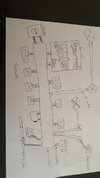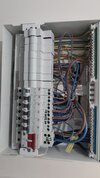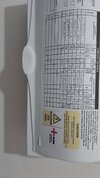Hello good people
I haven't worked in the industry and I have DIY experience.
I am studying the course at York college.
I have a practical exam coming up. So i just want to get some practice in beforehand. Got a couple of months left yet.
I've made or should I say attempted to make a little sketch of the board will be.
The consumer unit will have RCD protection although this board doesn't seem to have it.
Can someone please kindly walk through how to do some of the tests. Especially on rlthe ring circuit.
Ofcourse once the safe isolation is done... I've turned off everything. Etc etc.
I'll perform the dead tests and then move onto live tests.
My idea is start off with continuity . Link
Cpc to live at breaker. Check all lightings etc sperarely switch lamp. Then move onto the heater .
Repeat with line and neutral.. how would i do the ring and bonding and the metal tray? ? Would it be long lead method?
Then once that's done. Move onto Insularion resistance at 500v. 3 tests on each circuit.
Then live and rcd. I've not really done this before. I'll need to read more on this one.
Any help would greatly be appreciated.
Thank you
I haven't worked in the industry and I have DIY experience.
I am studying the course at York college.
I have a practical exam coming up. So i just want to get some practice in beforehand. Got a couple of months left yet.
I've made or should I say attempted to make a little sketch of the board will be.
The consumer unit will have RCD protection although this board doesn't seem to have it.
Can someone please kindly walk through how to do some of the tests. Especially on rlthe ring circuit.
Ofcourse once the safe isolation is done... I've turned off everything. Etc etc.
I'll perform the dead tests and then move onto live tests.
My idea is start off with continuity . Link
Cpc to live at breaker. Check all lightings etc sperarely switch lamp. Then move onto the heater .
Repeat with line and neutral.. how would i do the ring and bonding and the metal tray? ? Would it be long lead method?
Then once that's done. Move onto Insularion resistance at 500v. 3 tests on each circuit.
Then live and rcd. I've not really done this before. I'll need to read more on this one.
Any help would greatly be appreciated.
Thank you




